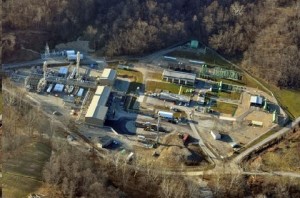PA-DEP says air emissions from gas drilling improve
From an Article by Laura Legere, Pittsburgh Post-Gazette, April 3, 2014
Harrisburg, PA — Air pollutants emitted by Pennsylvania’s natural gas industry stayed relatively level in 2012 — and remained a small fraction of the state’s total emissions — despite more pipeline and processing companies being required to report information to the state, environmental regulators told an air quality advisory board on Thursday. The PA Department of Environmental Protection released the first tally of air emissions information from shale and other unconventional natural gas drilling and pipeline companies last year.
The new inventory added for the first time data from processing plants and compressor stations that handle gas from conventional wells. Because of the change, 30 more midstream companies that run compressor stations and processing plants — or a total of 70 companies — reported emissions information for 2012. Fifty-six unconventional drilling companies reported their emissions, one fewer than 2011. Operators of conventional wells were not required to report their emissions.
Despite the added facilities included in the report, 2012 emissions of nitrogen oxides declined slightly to 16,400 tons from 16,500 tons in 2011. Mike Rudawski of DEP’s bureau of air quality attributed the flat level to the fact that more emissions from compressor station engines canceled out a decline in emissions from fewer operating drilling rigs.
PA-DEP saw an increase in emissions of volatile organic compounds from 2,800 tons in 2011 to 4,000 tons in 2012. Most of that increase came from compressor station engines, as well as from pumps and equipment leaks. The U.S. Environmental Protection Agency reports that volatile organic compounds “include a variety of chemicals, some of which may have short- and long-term adverse health effects.” Lung-damaging pollution is created by chemical reactions between nitrogen oxides and volatile organic compounds, especially during warmer times of the year.
“There are some significant emissions, as we expected when we decided to require the emission inventory,” Mr. Rudawski said during a meeting of the Air Quality Technical Advisory Committee. But new emissions from the growing natural gas industry have been more than offset by overall emissions reductions statewide, some of which are attributable to an increased use of natural gas instead of coal to generate power.
Overall sulfur dioxide emissions were cut by nearly 590,000 tons per year during the four-year span between 2008 and 2012. That improvement was credited to better control equipment on power plants, as well as more plants converting to natural gas, PA-DEP said. Overall emissions of nitrogen oxides declined 53,000 tons during the four-year period and volatile organic compounds declined 1,300 tons.
Committee member H. James Sewell, environmental and regulatory team leader for Shell Appalachia, said operators have already submitted their 2013 emissions data to the state and his company’s tally showed continued improvement. “In 2013, we show a decrease in [nitrogen oxides] in our drill rigs because of the use of natural gas instead of diesel fuel,” he said.
Committee member Kevin Stewart, director of environmental health for the American Lung Association of the Mid-Atlantic, said that although he was reassured to see the positive wintertime ozone data, he would like to see more detail on air pollution changes in the counties most affected by drilling.
“The inventory report is good for a broad look, but it is not designed to look at the kind of local exposures a particular household is getting immediately downwind, a few hundred yards from a facility,” he said. “Those are the kinds of things that also deserve the appropriate attention.”
>>>>>>>>>>>>>>>>>>>>>>>>
NOTE: There are three important points of monumental significance here. Firstly, Marcellus shale drilling and fracking for natural gas are very disruptive, inefficient and unsafe. Secondly, the leaked methane is an extremely potent greenhouse gas; and, the natural gas product when burned also produces a greenhouse gas (carbon dioxide). Thirdly, the nature and extent of Marcellus impacts in southwestern PA and northern WV can be seen so very clearly in the photo reports of the Marcellus-Shale.us web site here. Above photo from: www.Marcellus-Shale.us


{ 1 comment… read it below or add one }
A fourth important point is that the monitoring is being done by the very companies who have an interest in continuing their operations. Self-reporting, while better than no reporting, is not how these emissions should be determined. Independent investigation (not by DEP either) would prove more reliable.